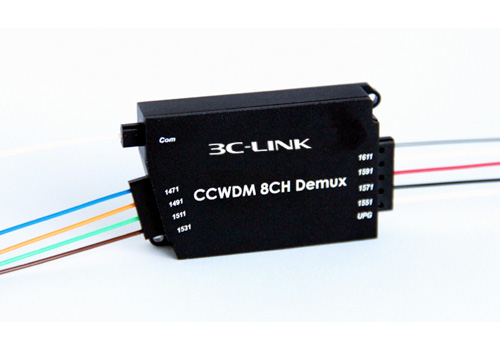
CCWDM Module
The customer has two equipment rooms separated by 200km and requires an optical transmission system to carry 100G/200G/400G services between them. 3C-LINK is tasked with designing a cost-effective, reliable, and future-proof solution.

Requirements Analysis:
Analyze service types (data, voice, video), transmission distance (200km), bandwidth (100G/200G/400G), and redundancy/quality-of-service (QoS) needs.
Network Topology:
Deploy a point-to-point (P2P) or dual-ring topology for redundancy.
Ensure fault recovery mechanisms like optical protection switching (OPS) or OTN-layer redundancy.
OTN/DWDM Equipment Selection:
Core Platform: 3C-LINK 3C-ONTS8600 OTN/DWDM platform, supporting 100G/200G/400G coherent optics and scalability to 1.6Tbps per fiber pair.
Optical Amplifiers: 3C-ONC-PA (Pre-Amplifier) and 3C-ONC-BA (Booster Amplifier) for 200km unrepeatered transmission.
Dispersion Compensation: 3C-ONC-DCM modules for chromatic dispersion management.
OTU Cards: 3C-ONC-OTU-100G/200G/400G line cards for client service aggregation and mapping into OTN frames.
Wavelength Planning:
Use C-band (1530–1565nm) with 50GHz/75GHz spacing for DWDM channel allocation.
Leverage flexible grid technology for mixed 100G/200G/400G transmission.
Performance Optimization:
Modulation: PDM-16QAM for 400G, PDM-QPSK for 200G/100G (balance between reach and capacity).
FEC: Enhanced SD-FEC (Soft-Decision Forward Error Correction) to improve OSNR tolerance.
EDFA Gain Control: Auto-adjusting amplifiers to maintain optimal power levels over 200km.
Fiber Characterization:
Deploy ultra-low-loss (ULL) single-mode fiber (e.g., ITU-T G.652.D) with attenuation ≤0.18 dB/km.
Ensure PMD (Polarization Mode Dispersion) < 0.1 ps/√km to support high-order modulation.
Network Management:
Integrate 3C-LINK NMS (Network Management System) for real-time monitoring of optical power, OSNR, BER, and latency.
Enable automated alarm correlation and proactive maintenance.
Testing & Validation:
Conduct pre-deployment tests: OSNR margin, nonlinear tolerance, and end-to-end BER < 1E-15.
Validate 400G performance using PRBS31 test patterns and RFC 6349 compliance.
Cost-Efficiency:
Eliminate midspan EDFA sites using high-gain amplifiers (>30dB) and Raman amplification (if fiber loss exceeds budget).
Future-proof design with pluggable optics (e.g., QSFP-DD/CFP2-DCO) for seamless upgrades to 800G/1.6T.
Equipment List (Per Site):
OTN/DWDM Platform: 3C-LINK 3C-ONTS8600II chassis (8 slots, 8.8T capacity).
Line Cards:
2x 3C-ONC-OTU-400G (CFP2-DCO coherent transceivers).
4x 3C-ONC-OTU-200G (QSFP-DD, programmable modulation).
8x 3C-ONC-OTU-100G (e.g., client services from IP routers).
Optical Layer:
3C-ONC-BA (Booster Amp: +23dBm output).
3C-ONC-PA (Pre-Amp: NF < 5dB).
3C-ONC-DCM (Dispersion Compensator for 200km G.652 fiber).
DWDM Mux/Demux: 40-channel flex-grid ROADM for wavelength routing.
Link Budget Calculation:
Fiber loss: 200km × 0.18 dB/km = 36dB.
Connector/splice loss: 3dB (allowance).
Total loss: 39dB.
Amplifier gain: Booster (+23dBm) + Pre-Amp (16dB gain) = 39dB (matches total loss).
OSNR margin: >18dB for 100G QPSK, >22dB for 400G 16QAM (using SD-FEC).
Advantages of 3C-LINK Solution:
No Midspan Sites: Saves CAPEX/OPEX by avoiding amplifier huts.
Multi-Rate Support: Mix 100G/200G/400G on the same fiber.
Sub-50ms Protection: Dual-homing and OTN switching for carrier-grade reliability.
For detailed proposals or customized designs, contact 3C-LINK’s technical team

Copyright © 2022 3c-link Corporation Limited.VOKO提供网站技术支持
Privacy Policy